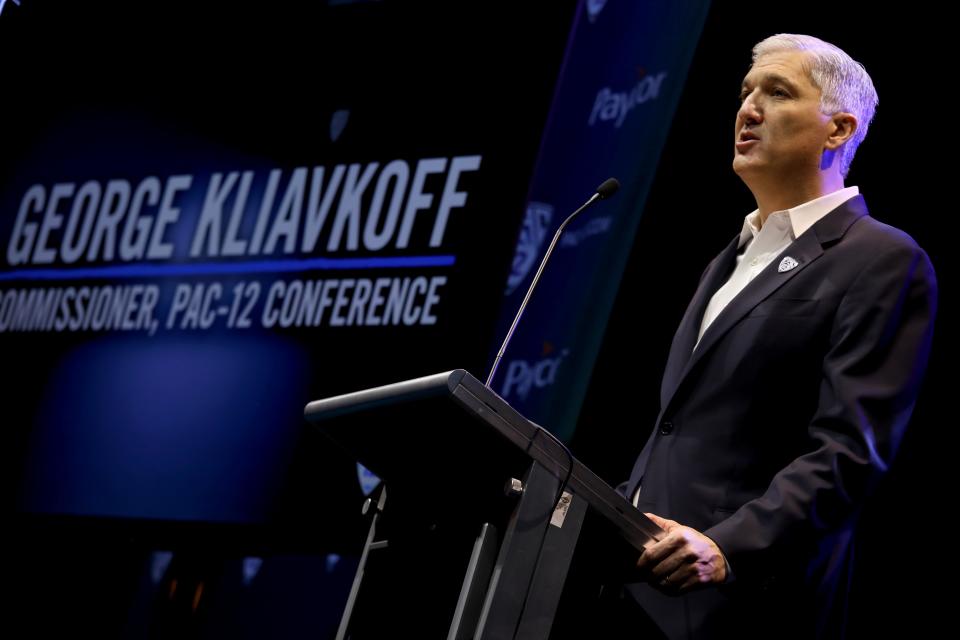Pac-12 commissioner George Kliavkoff spent much of his media day opening remarks Friday bemoaning the profiteering and professionalism of college athletics — yes, yes, bless his heart.
He talked about being “disappointed” that USC and UCLA are leaving for the Big Ten “after a century of tradition and rivalries.” He said that college sports have “collectively lost sight of the student-athlete.”
He pleaded for the industry to “recalibrate” because “our long-term measure … can’t be how much money we can consolidate … we should be measuring how many lives we can change.”
Then he mentioned that the Pac-12 was actively looking to expand and took a shot at a previous Big 12 comment about being “open for business.”
“We appreciate that,” Kliavkoff said. “We have not decided whether we’re going shopping there or not.”
In other words, which schools are the Pac-12 going to raid from the Big 12. (If any are even willing, which, of course, we’ll get to later).
Kliavkoff noted that was an aggressive line, but said he had no choice.
“I’ve been spending four weeks trying to defend against grenades that have been lobbed in from every corner of the Big 12 trying to destabilize our remaining conference,” Kliavkoff said. “When you look at the relative media value between the conferences, I get why they’re scared.”
This is modern college sports in a nutshell, a whipsaw back and forth from sepia-toned ideals and modern cutthroat capitalism. The people who run college sports — mostly football — can’t figure out what they want to be … other than well-compensated, of course.
Kliavkoff was bemoaning predatory conferences while threatening to be a predatory conference. And if he thinks it’s dishonorable or disloyal for USC and UCLA to jump from the Pac-12 to the Big Ten, then doesn’t all that also apply to the Pac-12 getting anyone to jump from the Big 12 or Mountain West?


Words are words. Media rights are media rights.
“Sometimes you just have to punch back,” Oregon athletic director Rob Mullens told reporters.
Indeed. And the Pac-12 needs to do plenty of punching if it wants to survive. It’s why Kliavkoff should scrap the hearts and flowers approach to describing college athletics.
This is a battle for money and only money.
“We are behind,” Kliavkoff said. “We have to close the gap in revenue.”
So can the Pac-12 actually poach from the Big 12?
A year ago, the answer was yes. It was the Big 12 that was reeling and vulnerable after Oklahoma and Texas announced they were leaving for the monied environs of the SEC. Any of the remaining eight schools would have jumped at a Pac-12 lifeline.
The Pac-12 didn’t call though. The Big 12 schools formed an odd bond born from being unwanted, added four new schools (BYU, UCF, Cincinnati and Houston) and regrouped. They aren’t what they were, but they seem unified.
Which is why new Big 12 commissioner Brett Yourmark made it clear his league was “open for business” … a clear nod to any Pac-12 school that sought stability to the East.
So now the question may be who wins this tug of war and will the Pac-12 regret not “destabilizing” the Big 12 when it had the chance.
The Big 12 is offering calm waters more than anything else. Everyone in the Pac-12 knows that Oregon and Washington are desperately trying to get into the Big Ten and would jump at an invite. Meanwhile, Stanford believes that if Notre Dame ever goes to the Big Ten as a 17th team, the Cardinal will be invited to come as well.
So the Pac-12’s future is based on hoping that desirable schools aren’t desired, because once they are, they are gone, a la the Bruins and Trojans, the moment their grant of rights ends.
It’s why the Big 12 is trying to draw in the remaining schools who are tired of getting ditched. Would Arizona and Arizona State see that league as a better fit? How about Utah or Colorado, which was a former Big 8 member?
This is like a Jenga tower, of course. If you get one, the whole place might collapse and then you pick whatever you want out of the rubble.
The Pac-12, meanwhile, might try to pluck the best of the Big 12 by waving what Kliavkoff suggests will be a richer television deal and access to the populous West Coast (even minus Los Angeles).
But would anyone go when loyalties seem shaky?
Or will the Pac-12 be forced to grab some Mountain West schools such as San Diego State, UNLV or Boise State? Or — more likely — just stick at 10 and hope for the best?
Whatever happens, the commissioners are saying the quiet parts out loud. Realignment often happens in silence. Not this time.
There is no collegiality, no commonality, no comity.
This is a fight, so ignore all that high and mighty rhetoric at the start because none of that applies here.
This is college athletics, after all.
